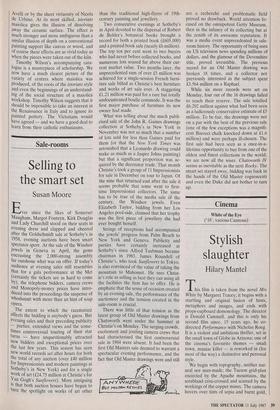Sale-rooms
Selling to the smart set
Susan Moore
Ever since the likes of Somerset Maugham, Margot Fonteyn, Kirk Douglas and Lady Churchill stood on their seats in evening dress and clapped and cheered after the Goldschmidt sale at Sotheby's in 1958, evening auctions have been smart Spectator sport. At the sale of the Windsor Jewels in Geneva in April, the gems encrusting the 2,000-strong assembly far outshone what was on offer. If today's audience at evening sales still resembles that for a gala performance at the Met (certainly the tickets are as hard to come by), the telephone bidders, camera crews and Monopoly-money prices have intro- duced into the proceedings the suspense of whodunnit with more than an hint of soap Opera.
The extent to which the razzmatazz affects the bidding is anybody's guess. But evening sales and their preceding publicity — parties, extended views and the some- times controversial touring of their star turns — have unquestionably attracted new bidders and exceptional prices over the last few years. This season has seen new world records set after hours for both the total of any auction (over £40 million for Impressionists and modern paintings at Sotheby's in New York) and for a single work of art (£24.75 million at Christie's for Van Gogh's Sunflowers). More intriguing IS that both auction houses have begun to turn the spotlight on works of art other
than the traditional high-flyers of 19th- century painting and jewellery.
Two consecutive evenings at Sotheby's in April devoted to the dispersal of Robert de Belder's botanical books brought a record for both a printed book (£605,000) and a printed book sale (nearly £6 million). The top ten per cent went to two buyers who had never before collected books, and numerous lots soared far above their cur- rent market value. Two months later, the unprecedented sum of over £5 million was achieved for a single-session French furni- ture sale billed as Christie's best furniture and works of art sale ever. A staggering £1.21 million was paid for a rare but totally undocumented boulle commode. It was the first major purchase of furniture its new owner had made.
What was telling about the much publi- cised sale of the John R. Gaines drawings collection at Sotheby's in New York in November was not so much that a number of lots sold for less than Gaines paid for them (or that the New York Times was astonished that a Leonardo drawing could make as much as a Jasper Johns painting) but that a significant proportion was ac- quired by the decorator trade. That month Christie's took a group of 11 Impressionists for sale in December on tour to Japan. Of the nine that returned east after the sale it seems probable that some went to first- time Impressionist collectors. The same has to be true of the media sale Of the century, the Windsor jewels. Even Elizabeth Taylor, bidding from her Los Angeles pool-side, claimed that her trophy was the first piece of jewellery she had ever bought herself.
Strings of receptions had accompanied the jewels' progress from Palm Beach to New York and Geneva. Publicity and parties have certainly increased at Sotheby's since Alfred Taubman became chairman in 1983. James Roundell of Christie's, who took Sunflowers to Tokyo, is also convinced of the value of taking the mountain to Mahomet. He sees Christ- ie's role as selling as best they can using all the facilities the firm has to offer. He is emphatic that the sense of occasion created by an evening sale, the performance of the auctioneer and the tension created in the sale-room is crucial.
There was little of that tension as the latest group of Old Master drawings from Chatsworth went under the hammer at Christie's on Monday. The surging crowds, excitement and jostling camera crews that had characterised the first controversial sale in 1984 were absent. It had been the first Old Masters sale deemed to warrant a spectacular evening performance, and the fact that Old Master drawings were and still are a recherché and problematic field proved no drawback. World attention fo- cused on the omnipotent Getty Museum, then in the infancy of its collecting but at the zenith of its awesome reputation. It was a media event unprecedented in sale- room history. The opportunity of being seen on US television news spending millions of dollars, and the glamour of the Devonshire title, proved irresistible. The previous record for an Old Master drawing was broken 18 times, and a collector not previously interested in the subject spent £3.564 million on a Raphael.
While six more records were set on Monday, four out of the 16 drawings failed to reach their reserve. The sale totalled £6.292 million against what had been seen as a ludicrously conservative estimate of £5 million. To be fair, the drawings were not on a par with the best of the previous sale (one of the few exceptions was a magnifi- cent Barocci chalk knocked down at £1.6 million) and were perhaps ill-chosen. The first sale had been seen as a once-in-a- lifetime opportunity to buy from one of the oldest and finest collections in the world; we are now all the wiser. Chatsworth IV seems as inevitable as the next Rocky. The smart set stayed away, bidding was back in the hands of the Old Master cognoscenti and even the Duke did not bother to turn up.


















































 Previous page
Previous page